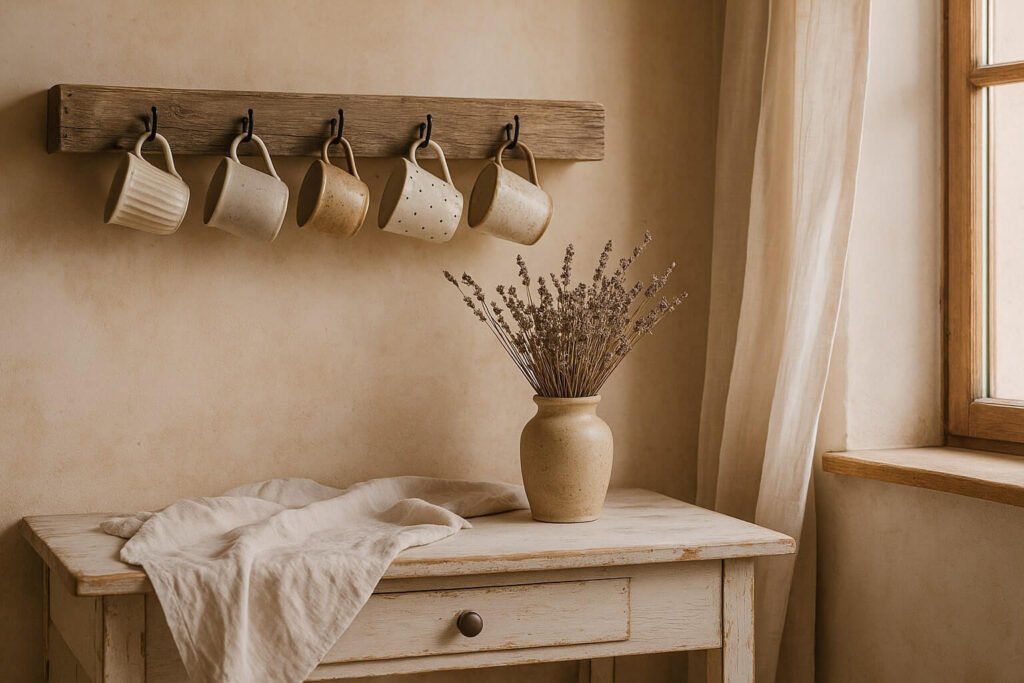There’s something about an old pine dresser, a well-worn wool blanket, and the gentle creak of reclaimed floorboards underfoot that makes a house feel like home. When I started updating our little semi in Derbyshire, I didn’t have a big renovation budget—just a car boot sale habit, a bucket of chalk paint, and a love for anything that looked like it had a story to tell. That’s how I fell headfirst into the world of Rustic Farmhouse Decor with a Cottagecore twist.
If you’re dreaming of a home that feels warm, nostalgic, and grounded in nature but you’re also working with a realistic UK budget, then welcome. This post is your thrifty guide to weaving rustic farmhouse charm into your own space—one salvaged timber shelf and linen cushion at a time.
What Makes Rustic Farmhouse Decor So Irresistible?
At its heart, Rustic Farmhouse Decor is about comfort, authenticity, and textures that tell a story. It’s mismatched crockery on open shelves, rough-hewn wood beams, and soft light filtered through billowing muslin curtains.
But when combined with the pastoral poetry of Cottagecore—with its appreciation for slower living, dried herbs, and hand-thrown pottery—the look becomes not just aesthetic, but soulful. It whispers of old English cottages, kitchen gardens, and rainy afternoons spent baking.
Finding Treasure in the Ordinary: Where to Source on a Budget
Most of my favorite pieces came from weekend treasure hunts: charity shops in the Peak District, local boot sales, and the ever-generous Facebook Marketplace. One time, I found an entire solid wood dining table for £25—it just needed a light sand and a good wax. That table now hosts everything from Sunday roasts to seed-sorting sessions.
Here are a few tried-and-true places to begin:
- Charity shops like Oxfam, British Heart Foundation, and smaller local ones are great for linens, ceramics, and small furnishings.
- Car boot sales (like those in Brighton or Lincolnshire) are goldmines for vintage tins, iron hooks, old toolboxes, and enamel jugs.
- Online marketplaces like Etsy UK and eBay can fill in the gaps with hand-thrown pottery, rustic signs, and vintage fabrics.
- Salvage yards often have reclaimed wood offcuts, fireplace surrounds, and old hardware for pennies compared to the big retailers.
Natural Materials Are Your Best Friend
The easiest way to create rustic warmth is by leaning into what nature gives us: wood, stone, wool, and linen. Even better when those materials are thrifted or salvaged.
Reclaimed Wood
I once picked up some floorboards from a neighbour’s skip (with permission!) and turned them into floating shelves for our kitchen. They were full of character—knots, scrapes, and all. With a little beeswax and bracket fixings, they became the perfect home for my collection of mismatched mugs.
Natural Textiles
Use linen tea towels as curtain valances, or turn vintage wool blankets into cushion covers. I made a set from an old Scottish tartan picnic rug, and they instantly warmed up our all-white living room.
Dried Florals
Herbs like lavender, rosemary, or thyme can be dried and tied with twine for wall accents or wreaths. In our hallway, a spriggy bunch of lavender hangs in an old jelly mould—and the scent never fails to make me smile when I come through the door.
Easy DIY Projects for That Handcrafted Look
The real joy of Rustic Farmhouse Decor lies in making it your own. You don’t need a sander the size of a spaceship or any fancy carpentry skills. Here are a few of my go-to DIYs:
Chalk-Painted Furniture
Chalk paint is a rustic decorator’s dream. I’ve painted everything from wardrobes to breadbins in creamy whites and muted sage. Don’t forget to lightly sand the corners for that “lived-in” look.
Shiplap Accent Wall
One Sunday, we added MDF panels to our downstairs loo, painted it in a soft grey-green, and suddenly it felt like a countryside retreat. Cost? Under £50.
Basket Storage
Use old fruit crates or wicker baskets for stylish storage. I found mine in a barn sale in Suffolk. We stack them under benches for shoe storage, and they even make nice planters for trailing ivy.
Styling It All Together: Balance, Texture, and Layers
Styling a Cottagecore-inspired farmhouse space doesn’t mean crowding every surface. Instead, think about creating intentional little scenes.
- Group items in threes: a jug, a candle, and a stack of books on a side table.
- Layer textures: linen runners on raw wood tables, wool blankets draped over ticking stripe cushions.
- Stick to an earthy palette: creams, muted greens, soft browns, and washed-out florals.
In our sitting room, I styled an old dresser with dried hydrangeas in a whisky bottle, a stack of Country Living magazines tied with twine, and an old tin bread bin holding spare candles. It didn’t cost much at all, but it feels right—like it grew there.
The Joy of Doing It Slowly
One of the best things about this style is that it rewards patience. You don’t have to transform your home overnight. Let it grow. Add pieces as you find them. Rework things you already have. Every scratch and chip tells part of your story.
If you’d told me five years ago that I’d be making my own furniture wax or rummaging through bins for broken ceramic handles, I’d have laughed. But now? It feels like home.
Before You Head Out Thrifting…
Here’s a quick checklist to keep in mind:
- Bring measurements and a tape measure.
- Always check for woodworm or structural damage.
- Look beyond the surface—an ugly finish might just need sanding or paint.
- Trust your gut. If something makes you smile, take it home.
A Home That Feels Like a Hug
Whether you live in a new-build flat or a countryside cottage, the Rustic Farmhouse Decor aesthetic offers a sense of grounding, warmth, and history. It doesn’t take a huge budget or a professional stylist—just a love for the worn and well-loved, a bit of creativity, and a Saturday morning at the boot sale.
So roll up your sleeves, grab that £20 side table, and start building a home that feels like a hug.


